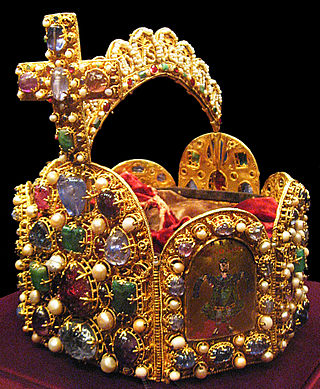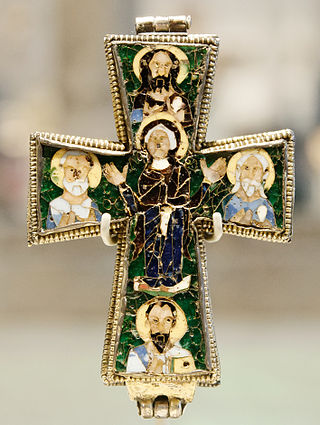
The prince-electors, pl. Kurfürsten, Czech: Kurfiřt, Latin: Princeps Elector) were the members of the electoral college that elected the ruler of the Holy Roman Empire.

Vitreous enamel, also called porcelain enamel, is a material made by fusing powdered glass to a substrate by firing, usually between 750 and 850 °C. The powder melts, flows, and then hardens to a smooth, durable vitreous coating. The word vitreous comes from the Latin vitreus, meaning "glassy".

The coat of arms of Germany displays a black eagle with a red beak, a red tongue and red feet on a golden field, which is blazoned: Or, an eagle displayed sable beaked langued and membered gules. This is the Bundesadler, formerly known as Reichsadler. It is one of the oldest coats of arms in the world, and today the oldest national symbol used in Europe.

Cloisonné is an ancient technique for decorating metalwork objects with colored material held in place or separated by metal strips or wire, normally of gold. In recent centuries, vitreous enamel has been used, but inlays of cut gemstones, glass and other materials were also used during older periods; indeed cloisonné enamel very probably began as an easier imitation of cloisonné work using gems. The resulting objects can also be called cloisonné. The decoration is formed by first adding compartments to the metal object by soldering or affixing silver or gold as wires or thin strips placed on their edges. These remain visible in the finished piece, separating the different compartments of the enamel or inlays, which are often of several colors. Cloisonné enamel objects are worked on with enamel powder made into a paste, which then needs to be fired in a kiln. If gemstones or colored glass are used, the pieces need to be cut or ground into the shape of each cloison.

An Imperial State or Imperial Estate was a part of the Holy Roman Empire with representation and the right to vote in the Imperial Diet. Rulers of these Estates were able to exercise significant rights and privileges and were "immediate", meaning that the only authority above them was the Holy Roman Emperor. They were thus able to rule their territories with a considerable degree of autonomy.

The Imperial Crown of the Holy Roman Empire, a hoop crown with a characteristic octagonal shape, was the coronation crown of the Holy Roman Emperor, probably from the late 10th century until the dissolution of the Holy Roman Empire in 1806. The crown was used in the coronation of the King of the Romans, the title assumed by the Emperor-elect immediately after his election. It is now kept in the Imperial Treasury at the Hofburg in Vienna, Austria.

King in Prussia was a title used by the Prussian kings from 1701 to 1772. Subsequently, they used the title King of Prussia.

A beer stein, or simply stein, is either a traditional beer mug made out of stoneware or specifically an ornamental beer mug sold as a souvenir or collectible. An 1894 article on beer mugs in the American Vogue magazine that describes various types of steins stated: "And it is to this [i.e. German] nation that we owe Wagner's music and the apotheosis of the beer mug."

The Austrian Crown Jewels are the regalia and vestments worn by the Holy Roman Emperor, and later by the Emperor of Austria, during the coronation ceremony and other state functions. The term refers to the following objects: the crowns, sceptres, orbs, swords, rings, crosses, holy relics and royal robes, as well as several other objects connected with the ceremony. The collection dates from the 10th to the 19th centuries, and it reflects more than a thousand years of European history. It is kept in the Imperial Treasury at the Hofburg Palace in Vienna, Austria.
The double-headed eagle is an iconographic symbol originating in the Bronze Age. A heraldic charge, it is used with the concept of an empire. Most modern uses of the emblem are directly or indirectly associated with its use by the late Byzantine Empire, originally a dynastic emblem of the Palaiologoi. It was adopted during the Late Medieval to Early Modern period in the Holy Roman Empire, Albania and in Orthodox principalities, representing an augmentation of the (single-headed) eagle or Aquila associated with the Roman Empire. In a few places, among them the Holy Roman Empire and Russia, the motif was further augmented to create the less prominent triple-headed eagle.

The Imperial Crown of Austria is a crown formerly in use by the monarchs of the Habsburg monarchy. The crown was originally made in 1602 in Prague by Jan Vermeyen as the personal crown of Holy Roman Emperor Rudolf II, and therefore is also known as the Crown of Emperor Rudolf II. The crown was used as a private crown of the Holy Roman Emperors and Kings of Hungary and Bohemia from the House of Habsburg. In 1804 it became the official crown of the newly constituted Austrian Empire. After 1867 it remained the imperial crown of the Cisleithanian part of the Austro-Hungarian Empire until 1918.

The Reichsadler is the heraldic eagle, derived from the Roman eagle standard, used by the Holy Roman Emperors and in modern coats of arms of Germany, including those of the Second German Empire (1871–1918), the Weimar Republic (1919–1933) and Nazi Germany (1933–1945).

Over its long history, the Holy Roman Empire used many different heraldic forms, representing its numerous internal divisions.

The Order of the Starry Cross is an imperial Austrian dynastic order for Catholic noble ladies, founded in 1668. The order still exists under the House of Habsburg-Lorraine.

The "Luck of Edenhall" is an enamelled glass beaker that was made in Syria or Egypt in the middle of the 14th century, elegantly decorated with arabesques in blue, green, red and white enamel with gilding. It is now in the Victoria and Albert Museum in London and is 15.8 cm high and 11.1 cm wide at the brim. It had reached Europe by the 15th century, when it was provided with a decorated stiff case in boiled leather with a lid, which includes the Christian IHS; this no doubt helped it to survive over the centuries.

The flag of the Holy Roman Empire was not a national flag, but rather an imperial banner used by the Holy Roman Emperor; black and gold were used as the colours of the imperial banner, a black eagle on a golden background. After the late 13th or early 14th century, the claws and beak of the eagle were coloured red. From the early 15th century, a double-headed eagle was used.

The craft of cloisonné enameling is a metal and glass-working tradition practiced in the Byzantine Empire from the 6th to the 12th century AD. The Byzantines perfected an intricate form of vitreous enameling, allowing the illustration of small, detailed, iconographic portraits.

Byzantine glass objects highly resembled their earlier Hellenistic counterparts during the fourth and early fifth centuries CE in both form and function. Over the course of the fifth century CE, Byzantine glass blowers, based mostly in the area of Syria and Palestine, developed a distinct Byzantine style. While glass vessels continued to serve as the primary vehicles for pouring and drinking liquid, glassware for lighting, currency and commodity weights, window panes, and glass tesserae for mosaics and enamels also surged in popularity. Following the Arab conquests of the seventh century CE, large quantities of glass were imported from the Levant, which continued to produce raw and manufactured glass. Scholars once believed that glassware was an expensive luxury good reserved for the upper strata of society, however, recent archaeological excavations have unearthed a considerable quantity of unadorned glassware intended for lower-class residents.

Enamelled glass or painted glass is glass which has been decorated with vitreous enamel and then fired to fuse the glasses. It can produce brilliant and long-lasting colours, and be translucent or opaque. Unlike most methods of decorating glass, it allows painting using several colours, and along with glass engraving, has historically been the main technique used to create the full range of image types on glass.

The Quaternion Eagle, also known as the Imperial Quaternion Eagle or simply Imperial Eagle, was an informal coat of arms of the Holy Roman Empire.




















